Geometry Homework Practice Workbook 1st Edition Chapter 2 Inductive Reasoning and Conjecture
Page 23 Problem 1 Answer
We have been given a figure where lines and planes intersecting each other or just passing one another.
We have to show line p lies in a plane N

First, we will identify plane N and locate line p, we see that the points D and A are on line p which lies in plane N So, according to postulate 2.5 which states that if two points lie in a plane then the entire line containing those points lies in that plane, we get that line p lies in plane N.

Hence by postulate 2.5, which states that if two points lie in a plane then the entire line containing those points lies in that plane, we get that line p lies in plane N.
Page 23 Problem 2 Answer
We have been given a statement that three collinear points determine a plane.
We have to show three collinear points to determine a plane is true or not.
If three collinear points intersect then their intersection of joining may be a line or plane Postulate 2.7 states that two or more points intersect then their join of intersection may be line or plane, so the statement is sometimes true.
Hence two or more points intersect then their join of intersection may be line or plane.
So the statement “Three collinear points determine a plane” is sometimes true.
Page 23 Problem 3 Answer
We have been given a statement two points A and B determine a line.
We have to show two points A and B determine a line.
Postulate 2.1 states that through any two points there is exactly one line possible in any direction.
So the statement is always true.
Hence the statement is always true as by postulate 2.1 that that through any two points there is exactly one line.
Page 23 Problem 4 Answer
We have been given a statement “a plane contains at least three lines”.
We have to whether a plane contains at least three lines or not.
A plane contains at least three non-collinear points. If two points lie in a plane, then the line containing them lies in the plane.
If two planes intersect, then their intersection is a line.
As the plane has three non-collinear points so we can say the plane can have three lines but by two parallel lines also we can make a plane.
So the statement is not always true.
Hence as the plane has three non-collinear points so we can say the plane can have three lines but by two parallel lines also we can make a plane.
So the statement “A plane contains at least three lines.” is not always true.
Page 23 Problem 5 Answer
We have been given figure as,

We have to show that G,P are collinear.
We know that points G,P lies in the same plane.
We also know that any two points in the same plane are always collinear.
So, we can say G,P are collinear.
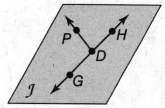
Hence, for the given figure, where, DG, and DP is in plane J, and H lines on DG, we stated the postulate that, two points in same plane are always collinear, to show that the given statement, G, P are collinear, is true.
Page 23 Problem 6 Answer
We have been given figure as,
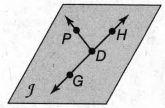
We have to show that G,P are collinear.We know that points G,P lies in the same plane.
We also know that any two points in the same plane are always collinear.
So, we can say G,P are collinear.
Hence, for the given figure,where, DG,DP is in plane J, and H lines on DG, we stated the postulate that, two points in same plane are always collinear, to show that the given statement, G,P are collinear, is true.
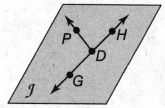
Page 23 Problem 7 Answer
We have been given figure as,We also have been given that B,C are the midpoints of AC,BD respectively.
We have to prove that AB=CD.
![]()
We can prove it using midpoint properties.
We have been given figure as,
![]()
As,B is midpoint of AC, so we get, AB=BC ……(1)
As, C is the midpoint of BD, so we get, BC=CD……(2)
By equating equations (1) and (2), we get,
![]()
AB=CD
Hence, for the given figure,where, point B is the midpoint of AC and C is the midpoint of BD, we wrote a paragraph proof and using midpoint properties we showed that AB=CD.
Page 24 Problem 8 Answer
We have been given a figure as,

We have to show that the lines l and m intersect at point Q.We know that intersection of two lines is always a point.
We know that planes J,K intersect at line m.We can see that line l lies on plane K.So, we can say that line l will also intersect line m.
So, we can say that the intersection point of lines l,m is point Q.
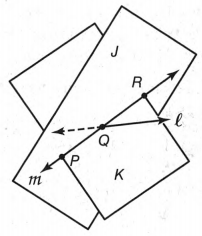
Hence, for the given figure,graphics 2 for exercise 2 page 24 geometry we explained that the given statement, the lines intersect at point, is true, by stating the postulate that, intersection of two lines is always a point.
Page 24 Problem 9 Answer
Here we have given a statement about the intersection of planes and we have to prove that whether the statement is true for always, never, or for sometimes.
So the given statement is the ”Intersection of two planes contains at least two points”.
So as we already know that in geometry two mutually intersecting planes are always formed a straight line.
In other words, two planes intersect each other at a straight line, and we also know a straight line is made up of two points.
Hence, it is obvious that as the two intersecting planes contain a straight line, they must contain at least two points on their surface always.
Here we have given a statement about the intersection of planes and we have to prove that whether the statement is true for always, never, or for sometimes.
So the given statement is the ”Intersection of two planes contains at least two points”.
So as we already know that in geometry two mutually intersecting planes are always formed a straight line.
In other words, two planes intersect each other at a straight line, and we also know a straight line is made up of two points.
Hence, it is obvious that as the two intersecting planes contain a straight line, they must contain at least two points on their surface always.
Page 24 Problem 10 Answer
In the question, here we have given that two lines i.e.
line m and the line TQ lie on the plane A as shown in Fig.1 below.
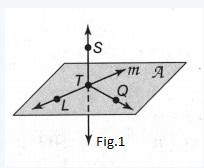
We have to tell that the points L,T and line m lies in the same plane.
So we already know that line m lies on the plane A and it clearly visible from Fig.1 that points L and T are one line m.
Thus ultimately we can say that the points L,T will lie on the plane A.
Hence we can say the points L,T and line m lies in the same plane i.e. plane A.
In the question, here we have given that two lines i.e. line m and the line TQ lie on the plane as shown in Fig.1 below.
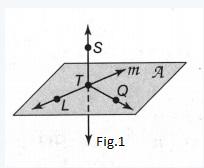
We have to tell that the points L,T, and line m lies in the same plane.
So we already know that line m lies on plane A and it clearly visible from Fig.1 that points L and T are one line m.
Thus ultimately we can say that the points L,T will lie on the plane A.
Hence we can say the points L,T and line m lies in the same plane i.e. plane A
Page 24 Problem 11 Answer
In the question, here we have given that two lines i.e. line m and the line TQ lie on the plane as shown in Fig.1 below.
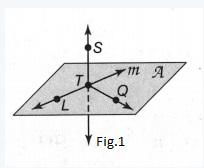
And we just have to prove that the lines m,ST intersect each other at a point T.
So it is very clear that from Fig.1 we can say that the lines i.e. line m and line TQ on plane A intersect at point T.
And as the line TS is also passing through that point T, hence we confidently can say that both the line m and TS are intersecting each other at point T.
In the question, here we have given that two lines i.e. line m and the line TQ lie on the plane as shown in Fig.1 below.

And we just have to prove that the lines m,ST intersect each other at a point T.
So it is very clear that from Fig.1 we can say that the lines i.e. line m and line TQ on plane A intersect at point T.
And as the line TS is also passing through that point T, hence we confidently can say that both the line m and TS are intersecting each other at point T.
Page 24 Problem 12 Answer
Here in the question, we have given that AB=CD and E is the midpoint of the lines AB,CD as shown in Fig.1 below.
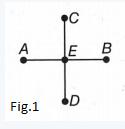
We have to write a paragraph proof of AE≅ED.So as we know That E is the midpoint of the line AB and CD, which means E is dividing the two lines i.e AB and CD into two equal parts.Hence implies that AE≅ED.
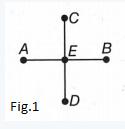
So as we know that That E is the midpoint of the line AB and CD, which means E is dividing the two lines i.e AB and CD into two equal parts.
Hence implies that AE≅ED.
Page 24 Problem 13 Answer
In this question, we have been given Points A,B and C are noncollinear.
Points B,C and D are noncollinear. Points A,B,C and D are noncoplanar.
We need to describe two planes that intersect inline BC.
By using Inductive Reasoning and Conjecture, we will calculate the result.
Since two points define a line, three-point define a plane.
Therefore, one plane passing through points B,C and A.
Point D in not included in this plane.
The other plane passing through the point B,C and D.
Point A in not included in this plane.
Thus, those two planes intersect inline BC.
Hence, those two planes intersect inline BC.
Since two points define a line, three-point define a plane.
The other plane passing through the point B,C and D.
